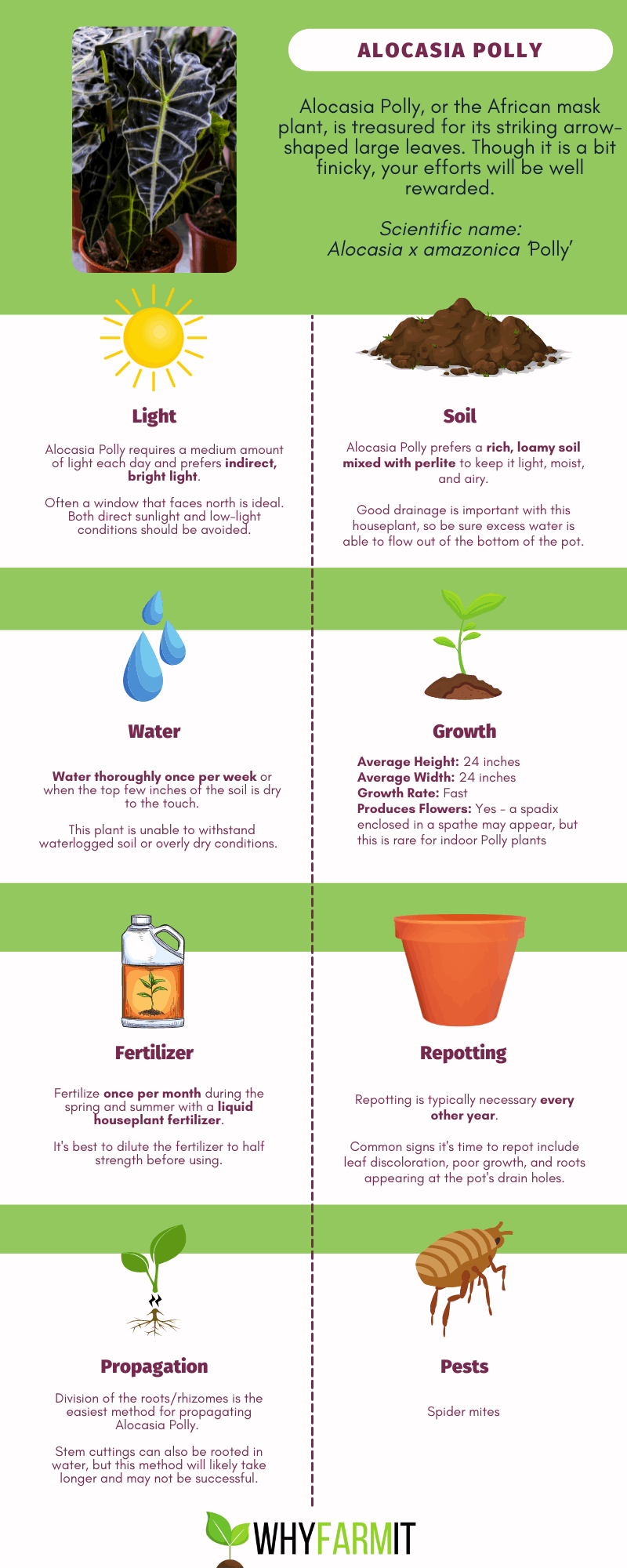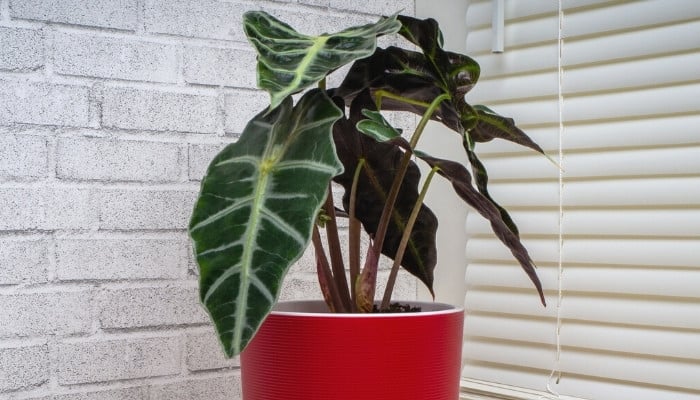The Alocasia ‘Polly’, often referred to as the African mask plant, is an attractively interesting mid-sized indoor plant. It flaunts large arrowhead-like leaves marked with veins in a silvery-green hue.
While Alocasia ‘Polly’ might be a little too difficult for a beginner, the care requirements are easy to manage once you figure out what this plant needs.
How do you care for Alocasia Polly? Alocasia ‘Polly’ will thrive when given bright indirect light, temperatures of 65-85℉, and relatively high humidity, but the most important factor in keeping this plant healthy is consistent watering. Water when the top 2 inches of soil is dry, and fertilize once monthly during growing season.
Caring for Alocasia Polly: Basic Guidelines
People bring Alocasia ‘Polly’ into their home because they are attracted to the beautiful and interesting leaves.
While this plant is especially particular in its water and humidity requirements, once you determine the needs of Alocasia ‘Polly’, you can have a happy plant for years to come.
Complete Care Guide for Alocasia Polly
Alocasia ‘Polly’ is actually a hybrid plant with unknown origins. It is thought to be related to Alocasia sanderiana, also known as the elephant ear plant or the kris plant.
Other Alocasia varieties are native to subtropical Asia and Australia.
Alocasia Polly at a Glance
- Plant type: Tropical
- Scientific name: Alocasia x amazonica ‘Polly’
- Average height: 24 inches
- Average width: 24 inches
- Growth rate: Fast
- Produces flowers: Yes, but rare indoors
- Common pests: Spider mites
- Life expectancy: 5 years
- Difficulty of Care: Moderate
What To Do When You First Get Your Alocasia Polly
Whenever you bring home a new plant, it is important to keep it quarantined from your other houseplants for at least two weeks.
After that time, if no pests or diseases are found, it can be placed in its permanent location.
It is also important to check the soil of your Alocasia ‘Polly’. If the soil is dry, water immediately because this plant is not drought tolerant.
Ideal Soil for Alocasia Polly
It is important for Alocasia ‘Polly’ to be planted in soil that will hold the appropriate amount of water while allowing excess water to fully drain.
A loamy soil mixed with perlite is a great option. The addition of perlite also adds air space to the soil so it is easier for the roots to grow.
Alocasia Polly Water Requirements
Alocasia ‘Polly’ is susceptible to both over and underwatering so maintaining a moderate amount of water is crucial for keeping the plant healthy.
In between waterings, allow the top 2-3 inches of soil to completely dry before watering again.
For most people, this means that Alocasia ‘Polly’ will need to be watered once a week.
If your area has especially hard water, Alocasia ‘Polly’ might prefer filtered or bottled water. Collected rainwater is also a good option.
When watering, continue watering until excess begins to drain out of the bottom of the pot.
Allow excess water to completely drain and discard any water remaining in the saucer.
Alocasia Polly Lighting Needs
Alocasia ‘Polly’ needs medium light conditions to survive. It does best near a window with bright, indirect light.
A northern-facing window creates the perfect conditions in most homes.
Direct sunlight will scorch the leaves and should be avoided. Thin curtains can be hung on a window near your Alocasia ‘Polly’ to filter any direct light.
In addition to avoiding direct light, low light should also be avoided. This plant cannot live in low-light conditions and will quickly suffer.
Ideal Temperature Range for Alocasia Polly
As a tropical plant, Alocasia ‘Polly’ prefers to be kept in warm conditions. The ideal temperature range is 65-85 degrees Fahrenheit.
Never allow the plant to go below 60℉, and avoid cold drafts and severe temperature fluctuations.
Ideal Humidity Level for Alocasia Polly
This plant loves humidity! To maintain the recommended humidity level of 60-75%, you can use a number of different methods, but misting regularly is the easiest.
You can also use a pebble dish or a humidifier, and house Alocasia ‘Polly’ near other plants to keep up ambient humidity.
Dry air will quickly diminish the health of your plant, so do not keep Alocasia ‘Polly’ near radiators, air vents, or stoves.
Best Location for Alocasia Polly
Alocasia ‘Polly’ will thrive in a warm, humid, bright environment. Therefore, a kitchen or bathroom can be a great location for this plant due to the higher humidity levels.
Just make sure that the plant is getting that all-important bright, indirect light.
Alocasia Polly Growth Habits
This fast-growing plant can put out 1-2 new leaves per month with optimal growing conditions. You can expect regular growth during the spring and fall.
During the winter, Alocasia ‘Polly’ goes through a dormancy period and will not produce new leaves. It is also possible for older leaves to wither and die off during dormancy.
Fertilization Type & Schedule for Alocasia Polly
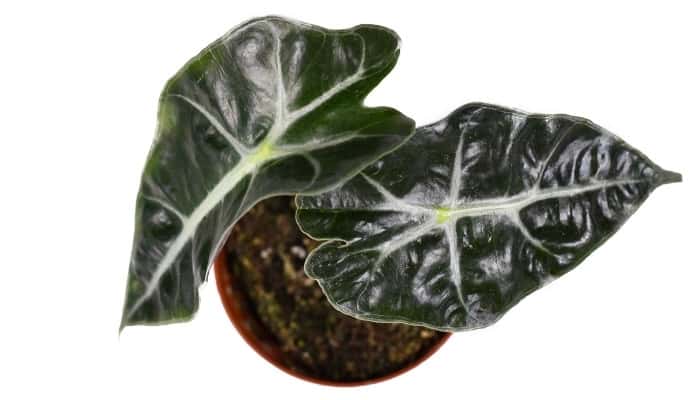
Use a liquid fertilizer formulated for houseplants for Alocasia ‘Polly’. Apply fertilizer once a month during the growing season (spring and summer).
Diluting the fertilizer to half strength will ensure that you are not overloading the plant with too many nutrients, which can cause health problems for Alocasia ‘Polly’.
Personally, I use organic products whenever possible and have had great results using this organic liquid fertilizer.
Signs of Nutrient Deficiency
- Nitrogen deficiency: yellowing leaves, especially lower and older leaves
- Calcium deficiency: new growth is misshapen and small
- Phosphorus deficiency: tips of leaves become dry and brown, older leaves darken in color
Pruning Alocasia Polly
Pruning your plant is only necessary for aesthetic reasons. It is also helpful to remove dead or dying leaves to prevent Alocasia ‘Polly’ from wasting resources.
When pruning, trim the stem of the leaf all the way at the base of the plant.
Does Alocasia Polly Produce Flowers?
When housed outdoors, Alocasia ‘Polly’ regularly produces flowers.
However, it is less common in houseplants, and optimal conditions need to be met to induce blooming.
Alocasia ‘Polly’ produces “spathe” flowers, which are multiple tiny flowers grouped on a stalk. The flowers look similar to a peace lily.
Many people prefer to trim off flower stalks once they see growth.
This is because the flowers are not especially beautiful and the blooms require a lot of nutrients from the plant.
It is common for a plant to lose a leaf or two when it is creating a flower.
Is Alocasia Polly Toxic?
Alocasia ‘Polly’ is toxic to humans and pets. It contains calcium oxalates, which can cause irritation of the mouth and stomach and even vomiting when ingested.
Alocasia Polly Propagation
Alocasia ‘Polly’ has rhizomes, which are underground stems that put up lateral shoots, which makes division the easiest propagation method.
Clumps of roots and corms (bulb-like structures on the roots) can be separated, thus dividing the plant into multiple new plants.
Root Division
1. Remove Plant From Pot
Gently remove your Alocasia ‘Polly’ from its pot. Loosen and remove the soil around the roots and corms.
2. Separate Roots Into Clumps
The roots and corms should have some natural clumps that can be gently separated from one another. Carefully pull the roots to separate the individual plants.
If the roots are too tightly bound, sterilized scissors can be used to cut them. Cut as few roots as possible to separate the new plants.
3. Pot New Plants
Your newly separated plants can now be transplanted into their own pots.
It is important to maintain moist soil and ambient humidity while the plants are getting established in their new pots.
Water Propagation
Water propagation is another way to create more Alocasia ‘Polly’ plants. It can be a fun way to propagate since you will be able to see the new roots forming.
1. Cut off a healthy leaf and stem.
2. Place stem in water.
3. Keep cutting in bright, indirect light.
4. Transplant to soil when roots are 1-2 inches long.
Repotting Alocasia Polly
This plant enjoys being fairly tight in its pot but not completely pot bound. It is likely that repotting will need to happen every couple of years.
Some people prefer the aesthetic of a smaller plant and pot, so they will divide the Alocasia ‘Polly’ into separate plants instead of moving to a larger pot.
When To Repot Alocasia Polly
It is time to repot your plant when the roots are filling out all the way to the edges of the pot.
Also, you may notice that growth has slowed or stopped, even during the spring and summer.
Signs That It’s Time To Repot
- Plant is root bound
- Plant has slowed or stopped growing
How To Repot Alocasia Polly
1. Find a New Pot
You should only size up your pot 1-2 inches in diameter. This prevents the plant from being shocked with too much new space.
Additionally, too much extra soil will hold excess water and can promote root rot.
2. Remove Plant From Old Pot
Gently remove your Alocasia ‘Polly’ from its old pot and loosen up the roots. It can be helpful to remove some of the old soil from around the roots.
3. Place in New Pot and Add Soil
Place an inch or two of fresh soil mix in the bottom of your new pot. Add your plant and gently fill the remaining area with soil mix. Do not pack the soil down too hard.
4. Water Thoroughly
Water your plant until excess is draining from the bottom. Allow the soil to drain completely and discard any water in the saucer before returning the plant to its location.
Alocasia Polly Common Problems & Solutions That Work
Alocasia Polly Common Pests
Alocasia ‘Polly’ is less susceptible to pest infestations than many other houseplants.
Since it enjoys humidity and moisture, it is important not to overwater as this can attract many pests. This plant is uniquely susceptible to spider mites when underwatered.
Spider Mites
Spider mites are one of the few pests that are attracted to dry conditions.
Spider mites feed on the chlorophyll in leaves, and they can spread extremely quickly, usually before you notice there is a problem.
Signs of Trouble
The first sign people will usually notice is yellowing leaves or leaves losing color. Upon inspection, the telltale webbing of spider mites is noticeable.
Solution
Immediately isolate your infected Alocasia ‘Polly’ from your other plants because spider mites can easily be transmitted.
Rinse the plant with cold water and gently wipe the leaves. Remove any yellow or brown leaves because they are too far gone to be saved.
Treat the plant with neem oil (I’ve found that this one is very effective) or an insecticidal spray (make sure that it is appropriate for mites).
Prevention
Check your plant regularly for signs of webbing or infestation. Do not allow your plant to dry out by keeping up a regular watering schedule.
You can also treat with neem oil occasionally as a preventative measure.
Alocasia Polly Common Diseases
Due to its love of moisture and humidity, Alocasia ‘Polly’ can fall victim to fungal infections like rust and root rot.
Well-draining soil is one of the best ways to prevent excess moisture.
Root Rot
Root rot can be caused by a number of different fungi and affects the roots of the plant first before spreading up the stem.
Signs of Trouble
Drooping leaves on a withering plant is the first sign of trouble for root rot.
You may also see the base of the stem turning dark brown or black. The base of the stem will also feel soft or mushy to the touch.
Solution
If root rot is suspected, it is important to inspect the roots. Any infected areas should be removed and discarded.
Sometimes it is possible to separate healthy parts of the plant. Replant any healthy portions left in pasteurized soil and avoid overwatering.
Prevention
Always house your Alocasia ‘Polly’ in a pot with a drainage hole so it is not sitting in excess water. Allow the top 2 inches of soil to completely dry before watering.
Rust
Rust is a fungal infection caused by high humidity, no direct sunlight, and warm temperatures. It can affect any part of the plant, but it is usually found on leaves.
Signs of Trouble
Tiny spots on leaves will pop up when infected with rust. The spots are orange to brown in color and will grow larger if left untreated.
Solution
Avoid overwatering your plant, and allow it to dry out as much as possible. Stop misting the leaves, so water is not left sitting on the leaves.
Any heavily infected should be pruned, and a copper fungicide (find it here on Amazon) may be applied to control the problem.
Prevention
Never overwater your plant or allow water to sit on the leaves. Maintain moderate water levels, and do not go overboard with ambient humidity.
Other Common Problems
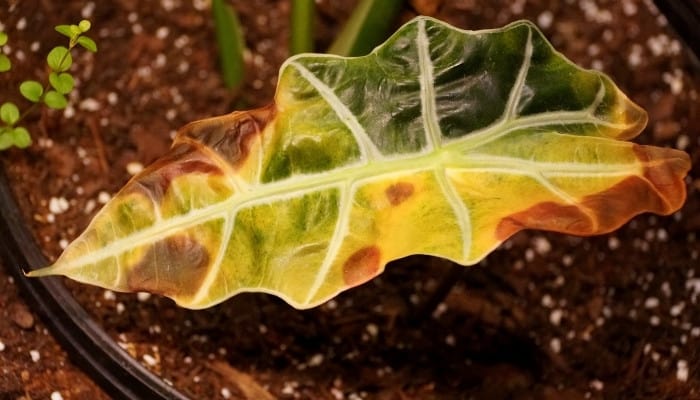
As you have already learned, moderation of watering is extremely important to the care of Alocasia ‘Polly’.
Too much or too little water is the cause of almost every issue for this plant.
Underwatering
Signs of Trouble
The edges of the leaves will turn brown and dry or they will begin to yellow. The leaves may also go limp and start to droop.
If completely dry, the soil will start to pull away from the edge of the pot.
Solution
If soil is not completely dry, water as normal.
If the soil is completely dry, bottom water the plant for up to 45 minutes or until the moisture has permeated all of the soil. Allow the pot to drain completely.
Prevention
Check the plant regularly, and water when the top 2 inches of soil are dry.
Overwatering
Signs of Trouble
Leaves will droop and yellow when there is too much water in the soil.
Solution
Allow the plant to dry out before next watering. Do not water until the top 2 inches of soil are dry.
Prevention
Use a pot with a drainage hole to prevent water from sitting in the soil. Always allow the top 2 inches of soil to dry before watering.
Alocasia Polly Common Questions
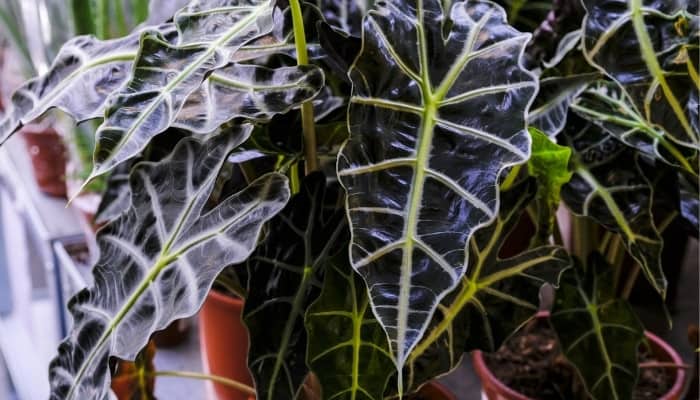
Is Alocasia Polly Difficult?
Alocasia ‘Polly’ is not a beginner plant, but it isn’t a terribly difficult plant either.
Due to its specific watering needs, it is important to have a general understanding of plant care to keep an Alocasia ‘Polly’ healthy.
Can You Grow Alocasia Polly in Water?
Alocasia ‘Polly’ can be grown in water. Remove all soil from roots before transplanting into water to prevent diseases.
Follow basic hydroponic practices (learn about hydroponic methods here) to keep your houseplant flourishing.
Should I Mist My Alocasia Polly?
Alocasia ‘Polly’ loves humidity and will benefit from regular misting. Just remain on the lookout for signs of disease and fungal issues.
Does Alocasia Polly Die in Winter?
Alocasia ‘Polly’ does not die in the winter, but the plant does go into a dormant period. Some older leaves may die off during dormancy.
This is completely normal and allows the plant to rest after an active growing season.
Does Alocasia Polly Have a Dormancy Period?
Alocasia ‘Polly’ will go dormant in winter and growth will slow or stop. You can cease fertilization during this time, but continue to water the plant as necessary.
Why Is My Alocasia Polly Dripping Water?
Dripping water is known as guttation, and it occurs when the plant is letting off excess water that it does not need.
This is usually a sign that you should cut back on your watering schedule.
Can You Bottom Water Alocasia Polly?
Alocasia ‘Polly’ can benefit from bottom watering. When bottom watering, soak until the soil is moist, and then allow the plant to drain completely.
How Can You Fix an Overwatered Alocasia?
If root rot is present, remove infected roots and stems and transfer to pasteurized soil and a new pot. Always allow the top 2 inches of soil to dry between waterings.
Why Is My Alocasia Polly Dying?
- Over/underwatering
- Too much/too little light
- Nutrient deficiency
- Pests or disease
Alocasia Polly vs Sanderiana
Alocasia sanderiana is also known as the kris plant. It can grow over 6 feet tall, and it is a possible hybrid parent of Alocasia ‘Polly’.
This plant is critically endangered in its native Philippines.
Alocasia Polly vs Bambino
Alocasia ‘Bambino’ looks similar to Alocasia ‘Polly’ with its arrowhead-shaped leaves and silver veins, but it is half the size.
Alocasia Polly vs African Mask
African mask plant is a common name used for many varieties of Alocasia, including Alocasia ‘Polly’.
The name comes from the shape and pattern on the leaves, which looks like a tribal mask.
3 Key Tips for Success With Alocasia Polly
1. Allow Soil to Dry Between Waterings
It is extremely important to allow the top 2 inches of soil to dry between waterings.
This helps combat overwatering, and when the soil is checked regularly, it can also prevent underwatering.
2. Avoid Direct Sunlight
Alocasia ‘Polly’ is susceptible to sunburn when exposed to direct sunlight. Additionally, the sunlight can also cause the soil to dry out quicker than usual.
3. Keep High Humidity
This tropical plant will thrive in a warm, humid environment. The ambient humidity will also help prevent spider mites from infesting your plant.
Conclusion
Other than maintaining an appropriate water level, Alocasia ‘Polly’ is a fairly easy plant to care for. Its leaf pattern is a unique and gorgeous addition to any home.
